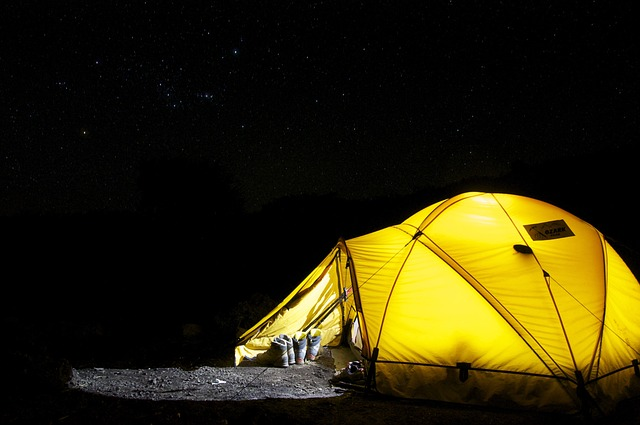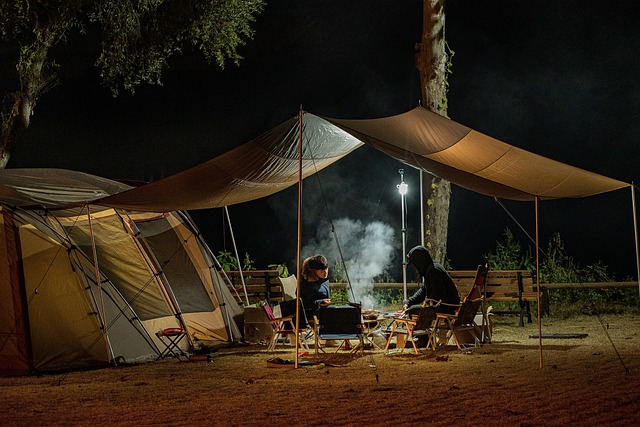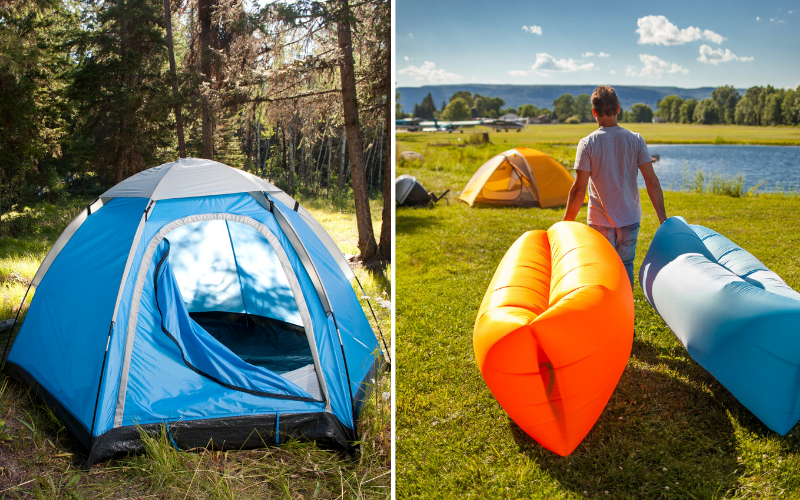Imagine the convenience of setting up a tent with just a few pumps of air, without the hassle of threading poles. Inflatable tents, also known as air tents, have revolutionized the camping experience by offering a comfortable and quick alternative to traditional pole tents.
In this blog post, we’ll dive into the world of inflatable tents, exploring their benefits, drawbacks, and top brands to help you make an informed decision for your next outdoor adventure. So, is it worth getting an inflatable tent? Read on to find out.
Key Takeaways
- Inflatable tents offer easy setup, durability and stability in adverse weather conditions, as well as versatility for various camping styles.
- They are heavier and bulkier than pole tents but may be a worthwhile investment due to their convenience and resilience.
- When selecting an inflatable tent consider your camping style, size & capacity requirements, features & materials.
Understanding Inflatable Tents

Inflatable tents:
- Utilize air-filled beams instead of conventional tent poles
- Provide a unique and comfortable camping experience
- Are just as capable of providing warmth at night as traditional poled tents
- Are designed to withstand various summertime weather conditions
Offering comfort and increased size and quality, these tents are quickly becoming a popular choice among campers. However, keep in mind that they are generally:
- Heavier
- Bulkier
- More costly than traditional pole tents
- More susceptible to punctures and repairs.
Inflatable Tent Components
An inflatable tent typically includes:
- Outer tent or rainfly
- Inner tent or tent body
- Groundsheet
- Guy lines
- Tent stakes
- Inflatable beams for support
The inflatable component of an air tent is generally composed of thermoplastic polyurethane, which is known for its durability and slight elasticity.
How Inflatable Tents Work
Constructed from the same durable materials as pole tents, air tents differ in their reliance on air-filled beams for structural support. These tents are inflated using a pump, eliminating the need for poles and simplifying the setup process. To pitch an air tent, simply unpack it, unfold it, and inflate it with air. When it’s time to break camp, deflate the tent, roll it up, and you’re ready to go.
In high winds, air tents maintain their stability through tensioning at both ends and the use of guy ropes around the perimeter. The supporting air beams may flex under the pressure of strong gusts but quickly return to their original shape when the wind pressure dissipates. This resilience in adverse weather conditions is a key advantage of air tents over traditional pole tents.
Advantages of Inflatable Tents

Air tents offer numerous benefits, such as rapid setup, robustness, and adaptability for a variety of camping styles. The convenience of quick setup and takedown makes them ideal for camping trips where time is a critical factor. Additionally, the durability of inflatable tents is noteworthy, as they are constructed with robust materials that can withstand challenging weather conditions.
Their versatility makes them a suitable choice for solo, group, and extended-stay excursions.
Easy Setup and Takedown
Inflatable tents can be erected quickly and effortlessly, making them perfect for campers who want to spend more time enjoying the great outdoors. One individual can conveniently assemble any of them, which is a significant advantage compared to traditional pole tents, which often require more time and labor to set up.
For example, the Osiris Air 500 tent weighs 15.3kg/33.7lb and has a pack size of 73 x 34 x 34cm/28.7 x 13 x 13in, while the Aether 450 air tent weighs 21.1kg/46.5lb and has a pack size of 73 x 42 x 42cm/29 x 16.5 x 16.5in.
Durability and Stability
Air tents are known to be quite durable and stable, able to withstand wind and other inclement weather conditions. However, not all air tents exhibit the same level of resilience. The air beams used for support may flex under the pressure of strong gusts, but they quickly return to their original shape when the wind pressure dissipates, making them more resilient in adverse weather than traditional pole tents.
Additionally, air tents are less prone to damage than pole tents due to their thermoplastic polyurethane construction, making them difficult to puncture.
Versatility in Camping Styles

The rapid setup, sturdiness, and adaptability of air tents make them an ideal selection for camping trips in a variety of conditions. Whether you’re embarking on a solo adventure, a group camping trip, or an extended stay in the great outdoors, air tents are suitable for various camping styles, meeting the needs of campers with diverse preferences and requirements.
Disadvantages of Inflatable Tents

While air tents offer numerous benefits, they also come with some drawbacks, such as their weight, price point, and susceptibility to punctures. These factors should be carefully considered when deciding whether an inflatable tent is the right choice for your camping needs.
Weight and Bulkiness
Inflatable tents can be more weighty and voluminous than conventional pole tents, which may be a concern for hikers and backpackers who need to keep their gear lightweight and compact. However, for car camping trips or other situations where weight and bulkiness are less critical, air tents can still be a convenient and comfortable option.
Cost
Air tents are typically more costly than pole tents, with a price discrepancy of approximately 20%. This higher price point may be a deterrent for budget-conscious campers, but for those who value the convenience and durability that air tents provide, the investment may be well worth it.
Potential for Punctures and Repairs
Inflatable tents are more susceptible to punctures and tears than traditional pole tents, and repairs can be challenging and expensive. However, with proper care and maintenance, the risk of punctures can be minimized, ensuring that your air tent remains a reliable shelter for many camping trips to come.
Comparing Inflatable Tents to Traditional Pole Tents

Both air tents and traditional pole tents have their advantages and drawbacks, and the best choice for your camping needs will depend on your personal preferences and requirements. This section compares air tents and pole tents, focusing on design, weather performance, and maintenance, to aid your decision-making process.
Design and Space Efficiency
Both air and pole tents offer efficient use of space, but pole tents may provide more interior living space due to the thinner poles used for support. Air tents, on the other hand, often provide more roomy interiors with ample headroom, due to their innovative design and air-filled beams.
Ultimately, the choice between air and pole tents will depend on your personal preferences and the specific needs of your camping trip.
Performance in Adverse Weather
Air tents demonstrate excellent performance in adverse weather conditions, exhibiting the capacity to rapidly regain their shape and resist wind. The supporting air beams may flex under the pressure of strong gusts but quickly return to their original shape when the wind pressure dissipates, making them more resilient in adverse weather than traditional pole tents. This resilience in adverse weather conditions is a key advantage of air tents over traditional pole tents.
On the other hand, traditional pole tents may be more suitable for extreme weather conditions, such as heavy snowfall, where additional structural support is required. It is essential to consider the type of environment and weather conditions you plan to camp in when choosing between an air tent and a traditional pole tent.
Maintenance and Repair
Maintenance and repair for air tents may involve patching punctures or fixing leaks, while pole tents may require pole replacement. Air tents can be more challenging to repair due to their unique construction, but with proper care and maintenance, they can provide a reliable shelter for many camping trips.
On the other hand, pole tents, which can be considered a type of traditional tent, may require more frequent pole replacements but can be easier to repair due to their more traditional construction.
Top Inflatable Tent Brands and Models

When it comes to inflatable tent brands, some of the most highly regarded are:
- Vango
- Outwell
- Coleman
- Berghaus
These brands are known for their superior quality and excellent performance, and they offer a range of air tents that cater to various camping styles and needs.
This section will familiarize you with some of the leading inflatable tent brands and models available in the market.
Vango AirBeam Tents
Vango AirBeam tents are renowned for their superior quality and excellent performance, offering a luxurious camping experience with the following features:
- Diamond Pro windows
- Darkened Midnight design
- Central lounge area
- Large panoramic windows and skylights
- Vango’s S.I. Inflation system
- Pole-free pitching
- Quick pitching time
While they come at a higher price point, investing in a Vango AirBeam tent reflects the brand’s commitment to providing a comfortable and reliable shelter for your camping adventures.
Outwell Inflatable Tents
Outwell inflatable tents offer innovative designs and features such as quick and easy setup, durability and stability, and versatility in camping styles. While they may not be as well-known as Vango AirBeam tents, Outwell’s inflatable tents still provide a reliable and comfortable shelter for campers seeking the convenience and durability of an air tent.
Other Notable Brands
In addition to Vango and Outwell, other reputable brands like Coleman and Berghaus manufacture reliable air tents that cater to various camping styles and needs. Some features of Coleman inflatable tents include:
- Multiple bedrooms with detachable dividing screens
- Generous sleeping compartments
- Swift and simple setup
- Ample interior space
- Top-notch materials
- Waterproof construction
- Blackout bedroom technology
Berghaus inflatable tents, on the other hand, are lightweight, simple to assemble, and boast a waterproof design, roomy interior, and premium materials, making them such a tent that campers would appreciate.
Tips for Choosing the Right Inflatable Tent

Selecting the appropriate inflatable tent involves taking into account your camping style, tent size, and features to ascertain they meet your needs. This section offers tips for evaluating these factors, aiding you in making the optimal decision for your camping requirements.
Assessing Your Camping Style
Your preferred camping style plays a crucial role in selecting the right air tent. Consider the type of camping you intend to do, the number of people you plan to camp with, and the type of environment you plan to camp in. By taking your camping style into account, you’ll be able to choose an air tent that’s best suited to your needs and preferences.
Considering Tent Size and Capacity
When choosing a tent size and capacity, take into account the number of fellow campers, the amount of equipment you intend to carry, and the size of the campsite you plan to occupy. By evaluating these factors, you can ensure that your air tent provides enough space and comfort for your camping trip.
Evaluating Tent Features and Materials
The durability and functionality of an air tent heavily depend on its features and materials. When assessing tent features and materials, evaluate the type of:
- fabric
- poles
- zippers
- ventilation
By examining these factors, you can ensure that your camping tent, air tent, and camping gear are built to last and will provide a comfortable and reliable shelter for your camping adventures.
Summary
In conclusion, inflatable tents offer a unique and comfortable alternative to traditional pole tents, with benefits such as quick setup, durability, and versatility in camping styles. However, they also come with some drawbacks, such as weight, cost, and susceptibility to punctures. By carefully considering your camping style, tent size, and features, and exploring top brands like Vango, Outwell, Coleman, and Berghaus, you can make an informed decision and choose the perfect air tent for your next outdoor adventure. So, gear up, inflate your tent, and embrace the great outdoors with the ease and convenience that air tents provide.
Frequently Asked Questions
What is better an air tent or pole tent?
Air tents have higher durability and strength, and although pole tents are relatively easy to set up with the right instructions, air tents remain a superior choice.
Are inflatable tents strong?
Inflatable tents are incredibly strong due to their air beams or tubes that provide stability and textiles that are resistant to tearing and punctures, making them able to withstand sharp and strong winds.
Do air tents get punctures?
Air tubes are tough and should last for years, but they are not immune to damage or punctures. To ensure your tent remains in good condition, it is recommended to have spares on hand in case something goes wrong.
What are some top inflatable tent brands?
Vango, Outwell, Coleman, and Berghaus are the top brands when it comes to inflatable tents, offering reliable and quality products.
What factors should I consider when choosing an inflatable tent?
When choosing an inflatable tent, consider your camping style and the size, capacity, features and materials to ensure you select one that meets your needs.
You Might Also Like...










